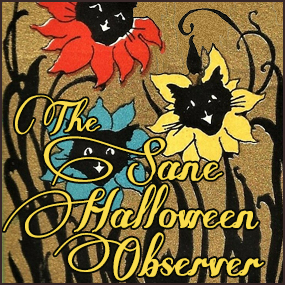Garden Path Collectibles
Sane Halloween Observer
Like a bit of everything these days, a collectibles onlooker might wonder if second-hand markets are touched by the effects of social (dis)information, as we find ourselves led down the garden path toward curious acquisitions. (Other entries discussing the jumbled landscape of assumption, visibility, and resale include: Bloody Paper Cuts, Time Capsule Ghosts, Yesterday's Prices at Today's Auctions, Diecut Bubble?, Diecut Bubble 2, as well as entry one which outlined issues of market engineering - Sane Halloween Observers).
While the activity of resale itself is not in question, we are however in an era when experts and promoters tossed out the conflict-of-interest rulebook to instead shake hands with sellers (not always with examination of wares) at the crossroads. Overall result - altered, improperly dated, and mis-identified items reaching escalated prices without censure.
Example one: the two skulls above were shorn of their crossbones, yet separately completed resales (from a guide's recommended re-seller) meant the unfortunate buyers paid around $40-50 each.To examine why we might take the any-and-everything approach to purchasing, here's one scenario that occurs often enough:
- a recommended re-seller scours a venue of less visible listings, buying at bargain-bin savings
- this new 2nd-tier owner (not always a collector) re-lists but with high visibility together with a vocal expert's praise, so that
- 3rd-tier buyers (some with seeming limitless cash as well as an awareness for the process) lift the final price to untenable results.
Perhaps this a good time for people to acquaint themselves with Tulip mania?
Example two: the three items above were bought online and are slowly being resold by a guide's recommended re-seller. The first was a guide-promoted sale (to deep pockets) multiplying the original purchase price for at least one card to a factor of 9x - with no mention of erasure nor added tassel. The second and third resold with no erasure yet with an added tassel.I suppose we could argue this is the game of resale, yet what are the lasting effects to market and valuation when middlemen play such influence on the narrative? While someone trained in statistics and probability (or at least all the time in the world to watch this stuff) will have no problem identifying the generated skews (such as price), what though of the general public unaware of such processes as those outlined herein - particularly when their purchasing decisions are connected to the stories (not necessarily the facts)? Perhaps an answer is for more guides to recommend objects over sellers, but how do such commentators separate the two when there is such apparent difficulty (or disregard) for keeping an eye on a fickle and complicated market? Once again it may all come down to the buyer. While it is just fine to find a guide through the garden, you yourself might want to push back a few weeds here and there along the way.
*****
If you are not keeping track of the numerous items (especially items previously thought to be rare) that hit the market, then this gallery, a fraction of what becomes available, may be of interest:
Follow VINTAGE Halloween Hoards on Pinterest.


